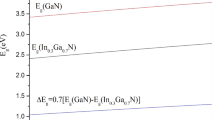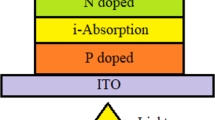Abstract
This study used a numerical model to analyze the Auger current in c-plane InGaN/GaN multiple-quantum well solar cells (MQWSC) under hydrostatic pressure. Finite difference techniques were employed to acquire energy eigenvalues and their corresponding eigenfunctions of \({\text{InGaN/GaN}}\) MQWSC. Besides, the hole eigenstates were calculated via a \(6 \times 6\) k.p method under applied hydrostatic pressure. Our calculations demonstrated that the hole-hole-electron (CHHS) and electron–electron-hole (CCCH) Auger coefficients had the largest contribution to the total Auger coefficient (i.e., 76 and 20%, respectively). Also, it was found that a pressure change of up to 10 GPa increases the carrier density in the quantum well and barriers. Based on the result, such a change could decrease the exciton binding energy, raise the quantum confinement of carriers, and decrease the Auger current in the multiple-quantum well and barrier regions. The solar cell’s performance is better when the Auger current is lower; thus, hydrostatic pressure plays a positive role in the performance of solar cells.















Similar content being viewed by others
References
A David and N G Young Phys. Lett. 115 193502 (2019)
C K Tan, W Sun and J J Wierer AIP Advances. 7 035212 (2017)
D Steiauf E Kioupakis and C G Van de Walle ACS Photonics. 1 643 (2014)
D P Han, C H Oh, D G Zheng, H Kim, J I Shim, K S Kim and D S Shin Jpn. J. Appl. Phys. 54 02BA01 (2015)
W Liu, C Haller, Y Chen and T Weatherley Phys. Lett. 116 222106 (2020)
E Kioupakis and P Rinke Phys. Lett. 98 161107 (2011)
J Piprek Phys. Status Solidi A. 207 2217 (2010)
M Auf, G der Maur, J M Moses and X Huang Gordon Energy Mater Sol. Cells. 230 111253 (2021)
J Piprek Phys. Lett. 106 101101 (2015)
H -Y Ryu, G H Ryu, C Onwukaeme and B Ma Opt. Express. 28 27459 (2020)
L Cheng, Z Li, J Zhang, X Lin, D Yang and H Chen S Wu and S Yao Nanomaterials. 11 2070 (2021)
S Picozzi and R Asahi Rev. Lett. 89 197601 (2002)
A S Polkovnikov and G G Zegrya Phys. Rev. B. 58 4039 (1998)
J Piprek Materials. 13 5174 (2020)
J M McMahon Rev. B. 105 195307 (2022)
B Chouchen and A T Hajjiah Phys. J. Plus. 137 1296 (2022)
B Chouchen, F Ducroquet, S Nasr and A Y A Alzahrani A T Hajjiah and M H Gazzah Solar Energy Materials and Solar Cells. 234 111446 (2022)
H Belmabrouk, B Chouchen, E M Feddi, F Dujardin and I Tlili M B Ayed and M H Gazzah Optik. 207 163883 (2020)
X Huang et al ACS Nano. 10 5145 (2016)
B K Ridley and W J Schaff J. Appl. Phys. 9 3972 (2003)
O Ambacher et al J. Phys. Condens. Matter. 14 3399 (2002)
A Asgari and K Khalili Sol. Energy Mater Sol. Cells. 95 3124 (2011)
V Fiorentini Appl. Phys. Lett. 80 1204 (2002)
P Perlin, L Mattos, N A Shapiro, J Kruger, W S Wong and T Sands J. Appl. Phys. 85 2385 (1999)
K J Bala Phys. 495 42 (2017)
S L Chuang and C S Chang Semicond. Sci. Technol. 12 252 (1997)
S L Chuang and C S Chang Phys. Rev. B. 54 2491 (1996)
J Piprek and S Nakamura IEE P-Optoelectron. 149 145 (2002)
R Yahyazadeh J. Photonics Energy. 10 045504 (2020)
A D Andrew and E O O’Reilly Appl. Phys. Lett. 84 182 (2004)
J Wang and P V Allmen J. Quantum Electron. 31 864 (1995)
A Asgari M Kalafi and L Faraone Physica E. 28 491 (2005)
W W -Ying Chin. Phys. B. 23 117803 (2014)
R Yahyazadeh Opt Quant Electron. 53 571 (2021)
R Yahyazadeh and Z Hashempour J. Nanophotonics. 15 036005 (2021)
S H Ha and S L Ban J. Phys. Condens. Matter. 20 085218 (2008)
J G Rojas-Briseno and I Rodriguez-Vargas M E Mora-Ramos and J C Martínez-Orozco Physica E. 124 114248 (2020)
P Harrison and A Valavanis Quantum Wells, Wires and Dots: Theoretical and Computational Physics of Semiconductor Nanostructures (New York: John Wiley & Sons) p 192 (2016)
E Kasapoglu Sci. Technol. 15 219 (2000)
J G Rojas-Briseño J C Martínez-Orozco and M E Mora-Ramos Superlattices Microstruct. 112 574 (2017)
D Watson-Parris, M J Godfrey and P Dawson Phys. Rev. B. 83 115321 (2011)
B Chouchen and M H Gazzah A Bajahzar and H Belmabrouk AIP Adv. 9 045313 (2019)
B Jogai J. Appl. Phys. 93 1631 (2003)
B Jogai Phys. stat. sol (b). 233 506 (2002)
I Vurgaftman J. Appl. Phys 89 5815 (2001)
S L Rumyantsev Summary. 14 1 (2004)
S W Corzine, L Coldren and M Mashanovitch Diode Lasers and Photonic Integrated Circuits (New Jersey: John Wiley & Sons) p 657 (2012)
G P Agrawal and N K Dutta Semiconductor Lasers (New York: Springer) p 448 (1993)
P S Zory Quantum well lasers (Boston: Academic Press) p 62 (1993)
S Adachi Physical Properties of III-V Semiconductor Compounds: InP, InAs, GaAs, GaP, InGaAs and InGaAsP (New York: John Wiley & Sons) p 290 (1992)
E Kioupakis, D Steiauf, P Rinke, K T Delaney and C G Van de Walle Phys. Rev. B. 92 035207 (2015)
V B Yekta H Kaatuzian Optik. 122 514 (2011)
J Hader J. Quantum Electron. 41 1217 (2005)
I H Tan and G L Snider J. Appl. Phys. 68 4071 (1990)
A Laubsch, M Sabathil and J Baur M Peter and B Hahn IEEE Trans Electron Devices. 57 79 (2010)
F Bertazzi, X Zhou and M Goano Phys. Lett. 103 081106 (2013)
F Bertazzi, M Goano and E Bellotti Appl. Phys. Lett. 97 231118 (2010)
B Chouchen and M H Gazzah A Bajahzar and H Belmabrouk Materials. 12 1241 (2019)
M H Gazzah and B Chouchena Sci. Semicond. Process. 93 231 (2019)
Author information
Authors and Affiliations
Corresponding author
Additional information
Publisher's Note
Springer Nature remains neutral with regard to jurisdictional claims in published maps and institutional affiliations.
Electronic supplementary material
Below is the link to the electronic supplementary material.
Appendices
Appendix A: Numerical method
The discretization of Schrodinger and Poisson equations has been performed using the finite difference method (FDM). A centered second-order scheme is used for this purpose. Therefore, a continuous term such as \(\frac{d}{dz}\left( {f\frac{d\psi }{{dz}}} \right)\) is discretized according to [58]:
The Schrodinger equation becomes: \(H\psi_i = E\psi_i\). The nonzero elements of the matrix H are:
It is straightforward to obtain the matrix system related to the Poisson equation.
The above eigenvalues system and linear system are coupled and should be solved using an iterative method. The convergence is obtained when the difference on the Fermi level associated with two consecutive iterations is smaller than \(10^{ - 4} eV\). The boundary conditions related to the Schrodinger equation are:
where L is the total height of the structure. The boundary conditions related to the Poisson equation are:
The details of the self-consistent solution of the Schrodinger–Poisson equation are as follows:
-
1.
Consider the optional value for \(n_{2D}\).
-
2.
Solve the Poisson equation.
-
3.
Solve the Schrodinger equation and obtain the wave functions and their energy subbands.
-
4.
Using the following equations and Eq. 5, the electron density and the Fermi energy are obtained as follows.
$$ E_F = E_0 + {{(\pi \hbar^2 n_{2D} )} / {m^* }} $$(15)$$ E_0 = {{(9\pi \hbar^2 e^2 n_{2D} )} / {(8\varepsilon_0 \sqrt {8m^* } \varepsilon_{GaN} )}} $$(16) -
1.5.
If it is \(E_{F\left( n \right)} - E_{F\left( {n - 1} \right)} < 10^{ - 4} eV\), the self-consistent program will end; otherwise,\(E_{F\left( n \right)} - E_{F\left( {n - 1} \right)} > 10^{ - 4} eV\). Put new \({n}_{2D}\) in Schrodinger’s equation and continue the program until the condition \(E_{F\left( n \right)} - E_{F\left( {n - 1} \right)} < 10^{ - 4} eV\) is established.
The same grid mesh is used for Poisson and Schrödinger’s equation during the calculations. For mesh refinement in the numerical calculation written in the MATLAB software, commands ‘initmesh’ and ‘refinemesh’ are performed as follows in different regions of structure InGaN/GaN.
fem. mesh = initmesh (fem,'hmax',[0.05e-9],'hmaxfact',1,'hgrad',1.3, 'zscale',1.0);
fem. mesh = refinemesh (fem, ‘mcase’,0);
where there are FEM commands in solving wave functions, hmax is the maximum edge size (= 0.05e-9m), hgrad is the mesh growth rate (= 1.3), and zscale is a region to be refined.
Appendix B: Electric fields
Assuming no free charge, electric displacements at the interface between \(\left( j \right)\) th and \(\left( {j + 1} \right)\) th layers and between \(\left( {j + 1} \right)\) th and \(\left( {j + 2} \right)\) th layers can be expressed as follows [20]:
Substituting from Eq. (17) gives an expression for Eq. (18):
where \(\varepsilon_j\) denotes the dielectric constants and \(P_j\) is the polarization in jth layer. In the following, the field in any layer is related to the field in a particular layer as:
We focus on the case where there is no voltage difference across MQW either because thermodynamic equilibrium prevails or an applied field exists that compensates for any built-in field. The condition in which the volt value dropped across MQW is zero is as follows:
Here, \(L_k\) and \(L_j\) are the kth and jth layer's thickness. Substituting from Eq. (19) gives an expression for electric field in any layer:
In the case of an MQW with only two types of layers (\(L_w\) and \(L_b\)), the fields are:
where the difference in polarization density is equal to surface polarization density in InGaN/GaN, which is calculated as follows [42, 59]:
where
Here, \(\in\) is the basal strain whose relation is presented in the main text.
Rights and permissions
Springer Nature or its licensor (e.g. a society or other partner) holds exclusive rights to this article under a publishing agreement with the author(s) or other rightsholder(s); author self-archiving of the accepted manuscript version of this article is solely governed by the terms of such publishing agreement and applicable law.
About this article
Cite this article
Yahyazadeh, R., Hashempour, Z. Numerical investigation of Auger current density in a InGaN/GaN multiple quantum well solar cell under hydrostatic pressure. Indian J Phys 98, 1217–1228 (2024). https://doi.org/10.1007/s12648-023-02897-4
Received:
Accepted:
Published:
Issue Date:
DOI: https://doi.org/10.1007/s12648-023-02897-4




